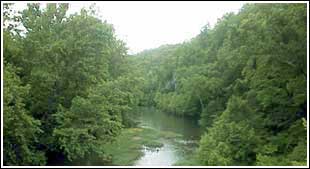The Scotch-Irish and the Coming of the Railroads

The first white settlers to arrive in the eastern
Ozarks likely came up the White River from the Mississippi around 1810,
and then up the Current, the Black, and the North Fork of the White
River from there, into the deep oak, pine and hickory forests of the
Ozark Highlands.
By 1800, most of the lands to the east had already
been settled and the land claimed. Those who arrived later had to choose
between going south around the rugged Ozarks hills, heading north toward
the St. Louis area, or simply forging ahead into the tangled wilderness.
The Scotch-Irish
Most of those who chose the third route were of Scotch-Irish
heritage, come to the new world as indentured servants, bondsmen, younger
children of landed gentry who had no hope of a sustainable inheritance,
and adventurous entrepreneurs. Some came escaping hardship and oppression;
some were fleeing the law. A more rough and tumble crew could scarcely
be found. They were searching for land for the taking. It would take
all the sweat, blood and tears of each of them to carve out a home in
this rock-hard, beautiful land. But settle it they did, and stayed.
It didn't stop them because in many ways it was just as beautiful, and
just as hard, as the lands from which they'd come. But where they'd
had nothing, here they could have what they could master. Today, a drive
down any country road in the watershed will still yield an abundance
of proud Scotch-Irish surnames, from Collins, Martin and Cochran to
Medlock, Harlin and Pease.
Like the Scotch-Irish, most northern Europeans sought
out a terrain more like that they'd left behind. Thus, most German natives
settled farther north around the Missouri River, or went on west to
the edges of the Great Plains. Scandinavians thought even that too temperate,
and headed north into what would become Wisconsin, Minnesota and the
Dakotas. A few of each group migrated into the Ozarks a little later,
after roads were built.
The Coming of the Railroads
The next wave of European migration into the Ozarks occurred
with the arrival of railroads. Newly arrived immigrants from many European
countries were pressed into service as laborers in the expansion of
the railway system. One railway line came east from Springfield and
passed through the northern edge of the watershed, leaving behind some
who quit laying track in order to settle on the high Ozarks plateau.
They built or enlarged the towns of Mansfield, Norwood and Mountain
Grove while the railroad continued on east to Willow Springs, where
the railway lines split. One portion continued on east to Poplar Bluff
and beyond, the other headed southeast through the towns of West Plains,
Brandsville, Koshkonong and Thayer before exiting the state at Mammoth
Spring, Arkansas. All along the line, names of Italian, Czech, Bavarian
and Bohemian extraction began to be added to county records. The Europeans
had arrived.
More about railroads
in the Ozarks, including a railroad spur built to connect the
main line at Mansfield with a growing settlement in a valley that would
be called Ava.

